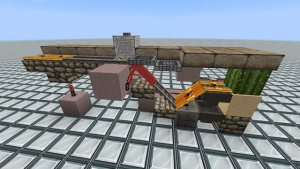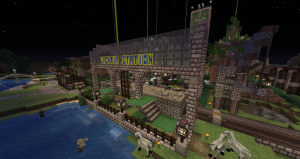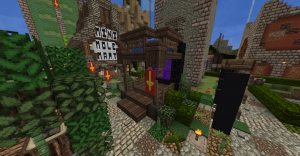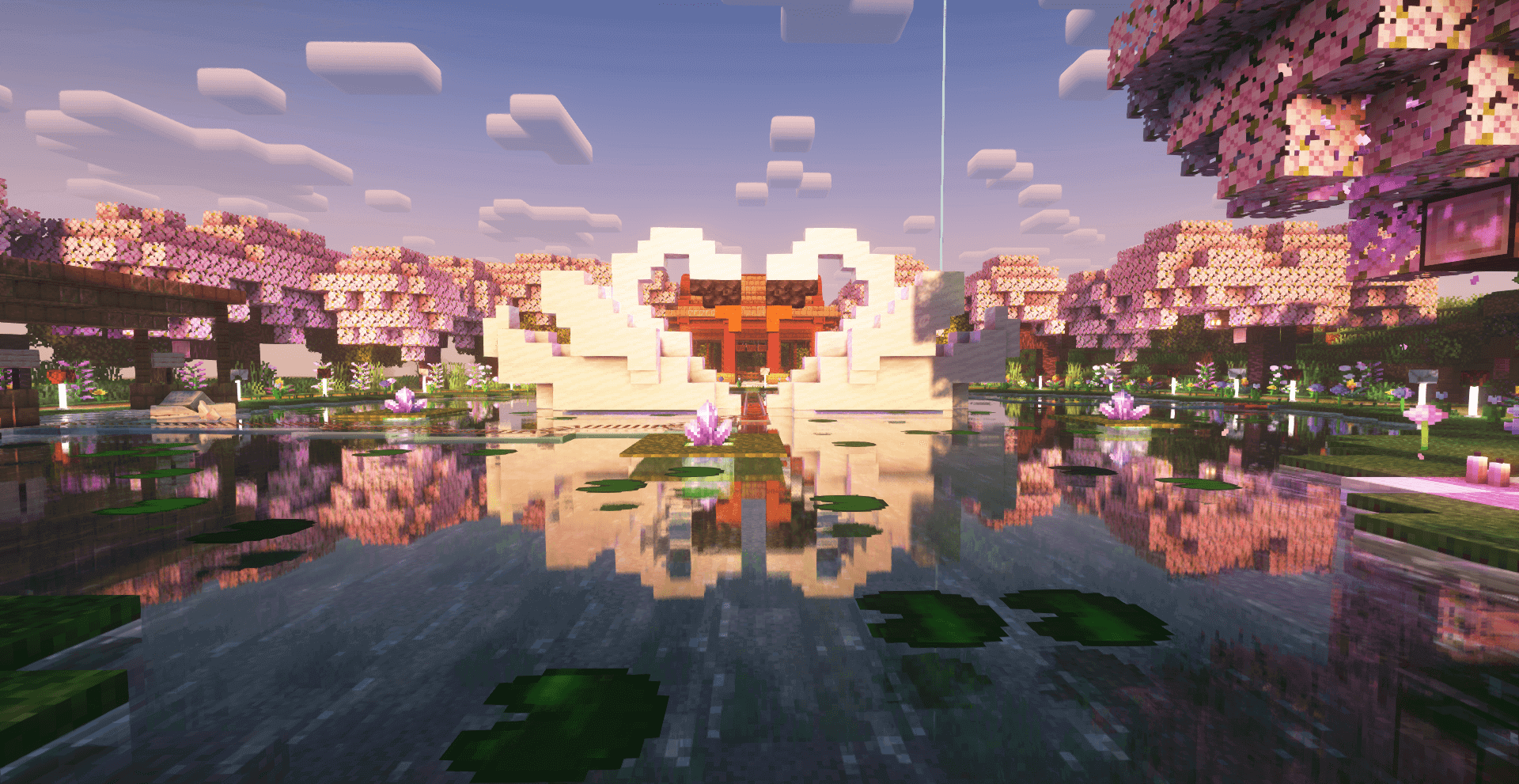Railway Stations on Survival 1
From Dogcraft Wiki
(Created page with "thumb|[[East Station (Survival 1)|East Station on the original Survival world, the first to be built with the standardized design.]] {{Quo...") |
No edit summary |
||
| (5 intermediate revisions by 2 users not shown) | |||
| Line 1: | Line 1: | ||
[[File:Survival 1 East Station.png|thumb|[[East Station (Survival 1)|East Station]] on the original Survival world, the first to be built with the standardized design.]] | [[File:Survival 1 East Station.png|thumb|[[East Station (Survival 1)|East Station]] on the original Survival world, the first to be built with the standardized design.]] | ||
{{Quote|A standard station design is also used, but the only component of it that is required is the basic platform with minecart dispensers, and a design that deviates from the standard can be used as long as it fits its surrounds.|{{Player|darparniox}}, in the original SRN forum thread}} | {{Quote|A standard station design is also used, but the only component of it that is required is the basic platform with minecart dispensers, and a design that deviates from the standard can be used as long as it fits its surrounds.|{{Player|darparniox}}, in [https://dogcraft.net/archive/index.php?topic{{=}}39.0 the original SRN forum thread]}} | ||
'''Railway Stations on Survival 1''', which formed the [[Survival Railway Network (Survival 1)|Survival Railway Network]] were the first of its | '''Railway Stations on Survival 1''', which formed the [[Survival Railway Network (Survival 1)|Survival Railway Network]] were the first of its kind on the [[Dogcraft Server]] and would define the systems of travel used on subsequent Survival Multiplayer [[Worlds|worlds]], with their influence and basic layout still being emulated in the network's current iteration. On the first [[Survival]] world, most Main line stations; albeit with some exceptions, followed the same documented design, with alterations to palette and shape made to accommodate local terrain. | ||
The design, created by {{Player|_edo}}, featured a central raised stone platform with curved glass roof bearing the station name in banners on the side. In the early days of the Survival Railway Network, the uniformity of stations allowed players to become quickly familiar with the railway system. The intuitive design boosted the network's recognition thereby elevating the project's status, while simultaneously making it easier for players to navigate the world. | The design, created by {{Player|_edo}}, featured a central raised stone platform with curved glass roof bearing the station name in banners on the side. In the early days of the Survival Railway Network, the uniformity of stations allowed players to become quickly familiar with the railway system. The intuitive design boosted the network's recognition thereby elevating the project's status, while simultaneously making it easier for players to navigate the world. | ||
== Features == | ==Features== | ||
{{SlidingGallery | {{SlidingGallery | ||
|size = 300 | |size = 300 | ||
| Line 17: | Line 17: | ||
Later, stations would be fitted with hot-air-balloons or other access portals to allow connection to the [[Nether Transport Network]] system. As the world progressed, experimentation with stations became more popular. Notably, stations like ''[[Dressrosa Station|Dressrosa]]'' featured custom platform designs more fitting of the base it served. In future worlds, designing unique stations for each stop along the network became preferred among SRN builders as players preferred variety; one critique of the standardization of railway stations is that it became monotonous to travel the network after a certain point. | Later, stations would be fitted with hot-air-balloons or other access portals to allow connection to the [[Nether Transport Network]] system. As the world progressed, experimentation with stations became more popular. Notably, stations like ''[[Dressrosa Station|Dressrosa]]'' featured custom platform designs more fitting of the base it served. In future worlds, designing unique stations for each stop along the network became preferred among SRN builders as players preferred variety; one critique of the standardization of railway stations is that it became monotonous to travel the network after a certain point. | ||
=== Stables === | ===Stables=== | ||
Railway stations often additionally featured stables where [[minecraft:Skeleton Horse|skeleton horses]] could be stored for new players to use for faster travel on ground. This was an extension of designer {{Player|_edo}}'s previous efforts in spawn city to build public stables in aid of improving the experience for players. | Railway stations often additionally featured stables where [[minecraft:Skeleton Horse|skeleton horses]] could be stored for new players to use for faster travel on ground. This was an extension of designer {{Player|_edo}}'s previous efforts in spawn city to build public stables in aid of improving the experience for players. | ||
=== Hot air balloons === | ===Hot air balloons=== | ||
[[File:North Station Survival 1 Hot air balloon.png|thumb|The yellow hot air balloon at [[North Station (Survival 1)|North Station]] on Survival 1.]] | [[File:North Station Survival 1 Hot air balloon.png|thumb|The yellow hot air balloon at [[North Station (Survival 1)|North Station]] on Survival 1.]] | ||
Perhaps the most unique and recognizable quirk of the Survival 1 network to players looking back was the presence of [[wikipedia:Hot air balloon|hot air balloons]] at many | Perhaps the most unique and recognizable quirk of the Survival 1 network to players looking back was the presence of [[wikipedia:Hot air balloon|hot air balloons]] at many SRN stations, which served three main purposes: | ||
* Underneath the hot air balloon would be a portal to the corresponding Nether Transport Network station, providing access to fast nether travel. Inversely, players travelling back through from the NTN would appear in a portal in the basket of the balloon. | |||
* Provide an aesthetically pleasing elytra take-off point, particularly useful on Survival 1 as rocket-based travel was not available until much later in the world's history and the update to 1.11. | *Underneath the hot air balloon would be a portal to the corresponding Nether Transport Network station, providing access to fast nether travel. Inversely, players travelling back through from the NTN would appear in a portal in the basket of the balloon. | ||
* Increase the visibility of stations at further distances and help identify them as important landmarks on the server. | *Provide an aesthetically pleasing elytra take-off point, particularly useful on Survival 1 as rocket-based travel was not available until much later in the world's history and the update to 1.11. | ||
*Increase the visibility of stations at further distances and help identify them as important landmarks on the server. | |||
[[File:Lackria_Hot_air_balloon_catcher.png|thumb|A "<abbr title="Colloquial term coined by ReNDoG for a water pool players drop into; named after his brother">goxy-drop</abbr>" catcher was positioned next to the portal under balloons so players could drop down safely.]] | [[File:Lackria_Hot_air_balloon_catcher.png|thumb|A "<abbr title="Colloquial term coined by ReNDoG for a water pool players drop into; named after his brother">goxy-drop</abbr>" catcher was positioned next to the portal under balloons so players could drop down safely.]] | ||
All hot-air balloons built on Survival 1 featured the same standard design, but each balloon used a different color. The color of the balloon corresponded to the color coding of each SRN station's "Nether" station on the NTN. On the network map, stations with hot air balloons were denoted with a small symbol. | All hot-air balloons built on Survival 1 featured the same standard design, but each balloon used a different color. The color of the balloon corresponded to the color coding of each SRN station's "Nether" station on the NTN. On the network map, stations with hot air balloons were denoted with a small symbol. | ||
| Line 31: | Line 33: | ||
The design of the server's hot air balloons attracted praise from many community members as a novel solution to the problems with ugly elytra towers (that led to an implementation of a rule banning them within spawn) as well as helping resolve portal synchronization problems; the NTN on Survival 1 was positioned just below the bedrock of The Nether ceiling, making linking portals with stations at lower altitudes challenging if there were nearby bases in the Overworld or other portals in The Nether. Despite this, the introduction of rocket-powered elytra flight, combined with the complexity of building a balloon compared to a station meant they became less popular as time went on and hot-air balloons did not return into service for the succeeding [[Survival Railway Network (Survival 2)|Survival 2 network]]. | The design of the server's hot air balloons attracted praise from many community members as a novel solution to the problems with ugly elytra towers (that led to an implementation of a rule banning them within spawn) as well as helping resolve portal synchronization problems; the NTN on Survival 1 was positioned just below the bedrock of The Nether ceiling, making linking portals with stations at lower altitudes challenging if there were nearby bases in the Overworld or other portals in The Nether. Despite this, the introduction of rocket-powered elytra flight, combined with the complexity of building a balloon compared to a station meant they became less popular as time went on and hot-air balloons did not return into service for the succeeding [[Survival Railway Network (Survival 2)|Survival 2 network]]. | ||
== Legacy == | ==Legacy== | ||
The design of SRN stations has been referred to "iconic" by a number of Dogcraft.net players through the years. A number of features first implemented in the stations of the original network have stuck, such as the hanging of SRN-brand banners, the presence of amenities such as maps and utility stations as well as the terminal design, which has remained relatively identical aside in principle, aside from the addition of Shulker box loading on Survival 2. | The design of SRN stations has been referred to "iconic" by a number of Dogcraft.net players through the years. A number of features first implemented in the stations of the original network have stuck, such as the hanging of SRN-brand banners, the presence of amenities such as maps and utility stations as well as the terminal design, which has remained relatively identical aside in principle, aside from the addition of Shulker box loading on Survival 2. | ||
[[Retro Station]], on the East Line of the [[Survival Railway Network (Survival 3)|Survival 3 Network]] replicated the design of a station on the original network in celebration of its | [[Retro Station]], on the East Line of the [[Survival Railway Network (Survival 3)|Survival 3 Network]] replicated the design of a station on the original network in celebration of its legacy. | ||
== Gallery == | ==Gallery== | ||
<gallery> | <gallery> | ||
File:Survival 1 Railway Platform demonstration.png | |||
File:Survival 1 South Station.png | |||
File:Survival 1 Spawn Station.png | |||
File:Survival 1 Stream Station platform.png | |||
File:Survival 1 Taiga Bay Station.png | |||
File:Survival 1 West Station.png | |||
File:Survival 1 Dressrosa Station.png | |||
File:Survival 1 East Station closeup.png | |||
File:Survival 1 East Station lamp.png | |||
File:Survival 1 East Station lengthways view.png | |||
File:Survival 1 East Station map.png | |||
File:Survival 1 East Station pre-Lackria-extension.png | |||
File:Survival 1 East Station stables.png | |||
File:Survival 1 East Station staircase.png | |||
File:Survival 1 East Station utility station.png | |||
File:Survival 1 East Station.png | |||
File:Survival 1 Lackria Station.png | |||
File:Survival 1 Mesa Station.png | |||
File:Survival 1 Minecart terminal cross section flipside.png | |||
File:Survival 1 Minecart terminal cross section.png | |||
File:Survival 1 North Station.png | |||
File:Survival 1 Pyramids Station platform.png | |||
File:Survival 1 Pyramids Station.png | |||
</gallery> | </gallery> | ||
---- | |||
{{Navbox Survival 1}} | |||
__NOTOC__ | __NOTOC__ | ||
[[Category: | [[Category:Stations]] | ||
Latest revision as of 20:57, 4 July 2021
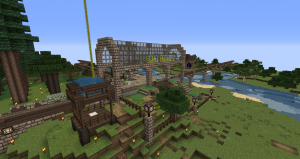
"A standard station design is also used, but the only component of it that is required is the basic platform with minecart dispensers, and a design that deviates from the standard can be used as long as it fits its surrounds."
darparniox, in the original SRN forum thread
Railway Stations on Survival 1, which formed the Survival Railway Network were the first of its kind on the Dogcraft Server and would define the systems of travel used on subsequent Survival Multiplayer worlds, with their influence and basic layout still being emulated in the network's current iteration. On the first Survival world, most Main line stations; albeit with some exceptions, followed the same documented design, with alterations to palette and shape made to accommodate local terrain.
The design, created by  _edo, featured a central raised stone platform with curved glass roof bearing the station name in banners on the side. In the early days of the Survival Railway Network, the uniformity of stations allowed players to become quickly familiar with the railway system. The intuitive design boosted the network's recognition thereby elevating the project's status, while simultaneously making it easier for players to navigate the world.
_edo, featured a central raised stone platform with curved glass roof bearing the station name in banners on the side. In the early days of the Survival Railway Network, the uniformity of stations allowed players to become quickly familiar with the railway system. The intuitive design boosted the network's recognition thereby elevating the project's status, while simultaneously making it easier for players to navigate the world.
Features
Although a standardized design was in place for public railway stations, players were encouraged to adapt station builds to the surroundings. For instance, Mesa Station was comprised of red sandstone blocks rather than plain stone bricks. The design itself is centered on a 23x7 raised platform, accessible via stairways. On opposite ends of the platform would be minecart terminals that could collect and summon Minecarts for passengers to use. Freestanding columns would support an arched roof, upon which banners would be hung displaying the station's name. All stations would also be equipped with utility stations, including an ender chest, publicly usable chest and crafting table. Later, stations would be fitted with hot-air-balloons or other access portals to allow connection to the Nether Transport Network system. As the world progressed, experimentation with stations became more popular. Notably, stations like Dressrosa featured custom platform designs more fitting of the base it served. In future worlds, designing unique stations for each stop along the network became preferred among SRN builders as players preferred variety; one critique of the standardization of railway stations is that it became monotonous to travel the network after a certain point.
Stables
Railway stations often additionally featured stables where skeleton horses could be stored for new players to use for faster travel on ground. This was an extension of designer  _edo's previous efforts in spawn city to build public stables in aid of improving the experience for players.
_edo's previous efforts in spawn city to build public stables in aid of improving the experience for players.
Hot air balloons
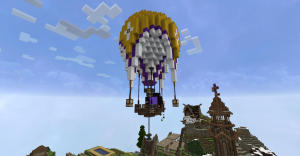
Perhaps the most unique and recognizable quirk of the Survival 1 network to players looking back was the presence of hot air balloons at many SRN stations, which served three main purposes:
- Underneath the hot air balloon would be a portal to the corresponding Nether Transport Network station, providing access to fast nether travel. Inversely, players travelling back through from the NTN would appear in a portal in the basket of the balloon.
- Provide an aesthetically pleasing elytra take-off point, particularly useful on Survival 1 as rocket-based travel was not available until much later in the world's history and the update to 1.11.
- Increase the visibility of stations at further distances and help identify them as important landmarks on the server.
All hot-air balloons built on Survival 1 featured the same standard design, but each balloon used a different color. The color of the balloon corresponded to the color coding of each SRN station's "Nether" station on the NTN. On the network map, stations with hot air balloons were denoted with a small symbol.
The design of the server's hot air balloons attracted praise from many community members as a novel solution to the problems with ugly elytra towers (that led to an implementation of a rule banning them within spawn) as well as helping resolve portal synchronization problems; the NTN on Survival 1 was positioned just below the bedrock of The Nether ceiling, making linking portals with stations at lower altitudes challenging if there were nearby bases in the Overworld or other portals in The Nether. Despite this, the introduction of rocket-powered elytra flight, combined with the complexity of building a balloon compared to a station meant they became less popular as time went on and hot-air balloons did not return into service for the succeeding Survival 2 network.
Legacy
The design of SRN stations has been referred to "iconic" by a number of Dogcraft.net players through the years. A number of features first implemented in the stations of the original network have stuck, such as the hanging of SRN-brand banners, the presence of amenities such as maps and utility stations as well as the terminal design, which has remained relatively identical aside in principle, aside from the addition of Shulker box loading on Survival 2.
Retro Station, on the East Line of the Survival 3 Network replicated the design of a station on the original network in celebration of its legacy.
Gallery
| ||||||||

